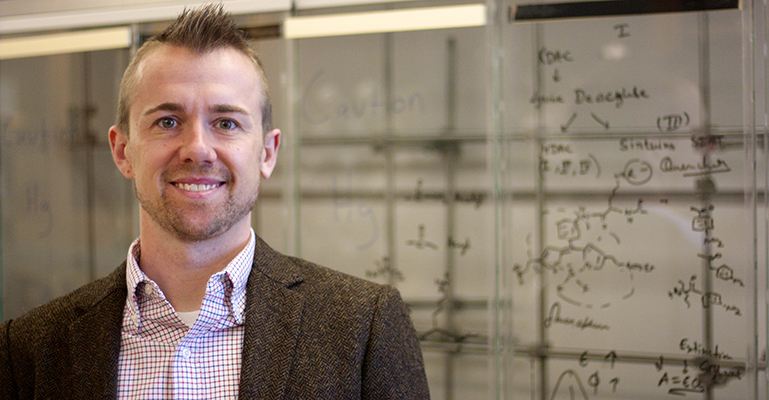The Faculty
Focus
The Dickinson group uses protein engineering and molecular evolution to produce new tools for cell biology and novel systems to study protein biochemistry.
Biography
Born Baltimore, MD 1984
University of Maryland, B.S., 2005
UC Berkeley, Ph.D., 2010
Postdoctoral Fellow, Harvard University, 2011-2014
Assistant Professor, UChicago 2014-
Accolades
2013 American Chemical Society Nobel Laureate Signature Award
2011 Jane Coffin Childs Memorial Fund for Medical Research Fellowship
2011 NIH Individual Postdoctoral Fellowship (declined)
Research Interests
Research in the Dickinson lab lies at the interface of chemistry, biology, and engineering. We exploit our expertise in protein engineering, molecular evolution, and cell biology to design and deploy new technologies for the interrogation of biological systems. Specifically, we seek to develop new methods to monitor and modulate chemical reactions in live mammalian cells, with a focus on decoding mammalian metabolic regulatory mechanisms. To accomplish this, we develop novel protein-based tools using a combination of continuous directed evolution, rational design, and computational approaches. Overall, our research is motivated by the belief that biological discovery can be spawned through the development and application of new technology. Current projects dealing with protein design and evolution include:
Encoding cellular events in polynuceotides with engineered molecular sensors. Current methods to monitor biochemical activities in live cells generally rely on optical reporters, impeding multiplexed analyses of biological systems. We will develop a new sensing strategy, using protein sensors that encode chemical events into defined sequences of polynucleotides, rather than changes in an optical reporter. This will permit high-throughput biochemical analyses of living systems using sequencing as the readout of specific cellular activities.
Reprogramming enzymes through continuous directed evolution. Evolution is a powerful mechanism with which to endow biomolecules with user-defined activities. However, traditional directed evolution approaches often fail to produce molecules with desired levels of activity, mainly due to limitations to the number of rounds of evolution that can be reasonably performed toward a particular evolutionary goal. Therefore, we will utilize Phage-Assisted Continuous Evolution (PACE) to reprogram important classes of biomolecules to produce novel research tools, starting points for therapeutics, and model systems for the study of evolution.
Selected Publications
Cao, Y.; Qiu, T.; Kathayat, R.; Azizi, S.-A.; Thorne, A.K.; Ahn, D.; Fukata, Y.; Fukata, M.; Rice, P.; Dickinson, B.C. “ABHD10 is an S-depalmitoylase affecting redox homeostasis through peroxiredoxin-5.” Nat. Chem. Biol. 15, 1232-1240 (2019).
Zinkus-Boltz, J.; DeValk, C.; Dickinson, B.C. “A phage-assisted continuous selection approach for deep mutational scanning of protein-protein interactions.” ACS Chem. Biol., 14, 2757-2767 (2019).
Rauch, S.; He., E.; Srienc, M.; Zhou, H.; Zhang, Z.; Dickinson, B.C. “Programmable RNA-guided RNA effector proteins built from human parts.” Cell 178, 122-134 (2019).
Zhou, H.; Rauch, S.; Qing, D.; Cui, X.; Zhang, Z.; Nachtergaele, S.; Sepich, C.; He, C.; Dickinson, B.C. “Evolution of a reverse transcriptase to map N1-methyladenosine in human mRNA.” Nat. Methods 16, 1281-1288 (2019).
Kathayat, R.S.; Cao, Y.; Elvira, P.; Sandoz, P.A.; Zaballa, M.-E.; Springer, M.Z.; Drake, L.E.; MacLeod, K.F.; van der Goot, F.G.; Dickinson, B.C. “Active and dynamic mitochondrial S-depalmitoylation revealed by targeted fluorescent probes.” Nat. Commun. 9, 334 (2018).




